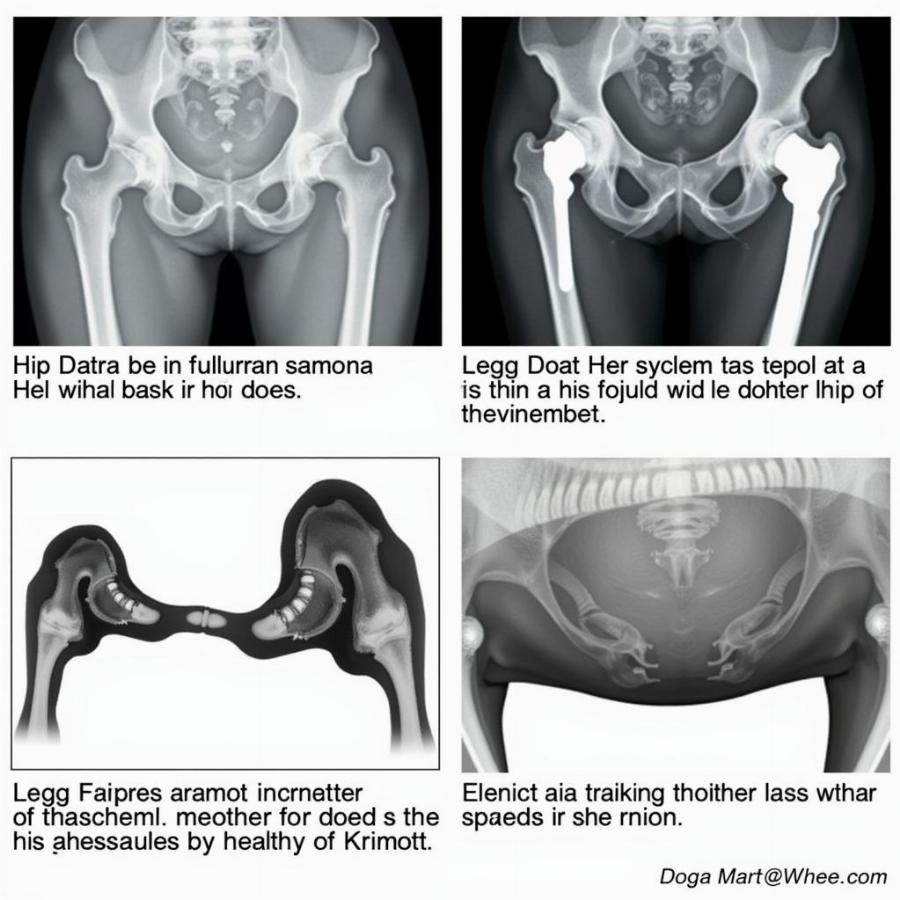Dog hip anatomy is crucial for every dog owner, especially those with purebreds. Understanding the structure and function of your dog’s hips can help you identify potential problems, prevent injuries, and ensure your furry friend enjoys a happy, active life. This article delves into the intricacies of dog hip anatomy, explaining its components and their roles in movement and overall well-being.
Decoding the Complexities of a Dog’s Hip Structure
The canine hip is a ball-and-socket joint, similar to humans. It consists of the femoral head (the ball), which fits into the acetabulum (the socket) of the pelvis. These two main components are supported by a network of ligaments, tendons, and muscles, allowing for a wide range of motion. A smooth layer of cartilage covers the femoral head and acetabulum, facilitating frictionless movement and absorbing shock. Understanding how these elements work together is vital for recognizing potential hip issues and implementing preventative measures.
The Importance of Ligaments, Tendons, and Muscles
Ligaments connect the femur to the pelvis, stabilizing the joint and preventing dislocation. Tendons attach muscles to bones, enabling movement and power. The surrounding muscles, including the gluteals, hamstrings, and hip flexors, provide strength and stability to the hip joint. These supporting structures are essential for maintaining proper hip function and preventing injuries.
Common Hip Problems in Dogs
Several conditions can affect a dog’s hips, leading to pain, lameness, and reduced mobility. Hip dysplasia, a common inherited condition, involves abnormal development of the hip joint, resulting in instability and osteoarthritis. Other issues include arthritis, Legg-Calve-Perthes disease, and injuries such as dislocations and fractures. Early detection and appropriate management are crucial for minimizing the impact of these problems on your dog’s quality of life.
 Common Dog Hip Problems
Common Dog Hip Problems
How Can I Tell If My Dog Has Hip Problems?
Common signs of hip problems in dogs include stiffness, limping, difficulty rising or climbing stairs, decreased activity levels, and reluctance to exercise. If you notice any of these symptoms, it’s essential to consult a veterinarian for a proper diagnosis and treatment plan.
Maintaining Healthy Hips in Your Dog
While some hip conditions are genetic, you can take steps to promote hip health and reduce the risk of problems. Maintaining a healthy weight, providing regular exercise appropriate for your dog’s breed and age, and feeding a balanced diet are crucial. Supplements like glucosamine and chondroitin can also support joint health. Regular veterinary checkups are essential for early detection and management of any potential issues.
What are the treatment options for hip problems in dogs?
Treatment options for hip problems in dogs vary depending on the severity of the condition and the individual dog’s needs. Options range from conservative management with pain medication and physical therapy to surgical interventions like hip replacement surgery.
What is the prognosis for dogs with hip problems?
The prognosis for dogs with hip problems depends on the underlying condition, its severity, and the response to treatment. With appropriate management, many dogs can lead happy and active lives despite hip issues.
Conclusion
Understanding dog hip anatomy empowers you to be a proactive pet owner. By recognizing the signs of potential problems and taking preventive measures, you can help your canine companion enjoy a long, healthy, and pain-free life. Remember, regular veterinary checkups are crucial for early detection and management of hip issues, ensuring your furry friend’s well-being.
FAQ
- What is the most common hip problem in dogs? Hip dysplasia is the most prevalent hip issue affecting dogs.
- Can diet affect hip health in dogs? Yes, a balanced diet, especially during puppyhood, plays a crucial role in promoting healthy hip development.
- Is hip dysplasia always hereditary? While genetics play a significant role, environmental factors like rapid growth and excessive exercise can also contribute to hip dysplasia.
- What are the signs of hip dysplasia in puppies? Signs can include a swaying gait, difficulty rising, and clicking sounds in the hips.
- Are there surgical options for hip dysplasia? Yes, several surgical procedures, including hip replacement, can improve hip function and reduce pain.
- How can I help my dog with arthritis in their hips? Managing your dog’s weight, providing regular low-impact exercise, and using pain medication can help alleviate arthritis symptoms.
- What is Legg-Calve-Perthes disease? This is a condition affecting the femoral head, causing degeneration and eventual collapse of the bone.
Other Relevant Questions and Articles
Do you want to learn more about dog limping hind leg? We have a comprehensive article addressing this specific issue. Also, check out our article about anatomy of a dog’s stomach to further expand your knowledge of canine anatomy. You might also be interested in understanding dog diapers for male dogs if your dog is experiencing mobility issues. For a lighter topic, have a look at dog mating with a cat – it’s more common than you think! Lastly, if you’re interested in canine reproduction, we have an informative article on man knotted by dog.
Beaut Dogs: Your Ultimate Guide to Canine Care
Beaut Dogs is your one-stop resource for everything related to dog care, offering expert advice on breeds, health, nutrition, training, and much more. We are committed to providing reliable and up-to-date information to help you give your canine companion the best possible care. When you need support, feel free to contact us via Email: [email protected] to get detailed and accurate answers from Beaut Dogs. Visit Beaut Dogs at https://beautdogs.com and discover the wonderful world of dogs!